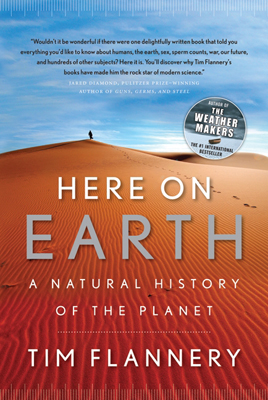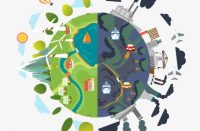Here on Earth: A Natural History of the Planet is as much a personal letter to humanity as a natural history of the planet. It asks, “Will ours be a Medean or Gaian future?”, referring to diverging hypotheses named for Greek goddesses, one destructive and the other life-giving.
Here on Earth: A Natural History of the Planet is as much a personal letter to humanity as a natural history of the planet. It asks, “Will ours be a Medean or Gaian future?”, referring to diverging hypotheses named for Greek goddesses, one destructive and the other life-giving. Tim Flannery – Australian scientist, Copenhagen Climate Council chairman and author of The Weather Makers – argues that rather than being a foregone conclusion, “what we believe…will determine our fate.” The time to decide what we believe, he says, is upon us.
The Medea hypothesis, forwarded in 2009 by paleontologist Peter Ward, argues that “species will, if left unchecked, destroy themselves by exploiting their resources to the point of ecosystem collapse.” Life ultimately destroys life, as Medea murdered her children. Carbon-cycle disruptions, such as contemporary anthropogenic climate change, are a hallmark of such extinction events. Flannery asks whether this means that humans, “Medea-like, are destined to destroy most other life, condemning our descendents to a new Dark Age, or outright extinction?”
Disturbed by such a prospect, Flannery turns to the Gaia hypothesis proposed in 1972 by British scientist James Lovelock. The Gaia hypothesis posits that earth is a self-regulating system that maintains conditions favourable to life. Coral reefs releasing cloud-forming chemicals that in turn shade the coral. Rainforests generate rainfall through transpiration. Flannery observes that “if competition is evolution’s motive force, then the cooperative world is its legacy.” His comparison of photosynthesis to marriage underlines his point.
In this wide-ranging volume, Flannery tells the story of earth’s origins starting with the Big Bang: “The elements that form us, the carbon, phosphorous, calcium and iron to name but a few, were created in the hearts of stars.” He outlines the workings of the earth’s crust, oceans and atmosphere in accessible, engaging language, highlighting Medean extinctions and Gaian superorganisms. His discussion of ways to move forward is pat and uneven, but nonetheless includes interesting strands that inspire, including mention of a proposed Clean Energy Bank.
Flannery, with impassioned optimism, advocates for the possibility of a Gaian future. However, he makes clear that such a future requires conscious and determined decisions. One expression of such a future is a campaign launched in 2010 to recognize ‘ecocide’ – ecosystem destruction that disrupts peace – as a crime at the United Nations’ International Criminal Court. Flannery ends his letter with a certainty: “If we do not strive to love one another, and to love our planet as much as we love ourselves, then no further human progress is possible here on Earth.”
Here on Earth: A Natural History of the Planet, Tim Flannery, Toronto: Harper Collins, 2010, 316 pages
Subscribe now to get more book reviews in your mailbox!
Reviewer Information
Stephanie Sodero volunteers for the Ecology Action Centre, a sparkling Nova Scotian environmental non-profit organization, and drinks Halifax tap water.












